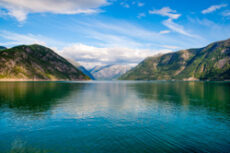
Lysefjorden is the most southerly “large fjord” in Norway and is often considered one of the country’s most beautiful natural attractions thanks to its convenient location. From Stavanger’s central harbor, you can board a sightseeing cruise. You can drive alongside a section of it or go up to Pulpit Rock and Kjerag, but a boat ride down the fjord will give you the whole experience. Tourists are flocking to see the world’s longest wooden staircase, which features 4444 steps and is located in Florli. If you’re in top physical condition, you may put your fitness to the test by ascending the stairs. If you’re in good enough shape, you can walk the entire length of the fjord by following the pathways marked “Lysefjorden around” by the Stavanger Tourist Board. At the mouth of the fjord is an extreme sports mecca. At the mouth of the Lysefjorden sits the city of Forsand and the ferry terminal in Oanes.
Tourist boats frequently dock on the fjord to take in the sight of Hengjanefossen, unless the captain decides to get dangerously close. You may also see the 400-meter-high waterfall up close on a mountain hike along the Lysefjorden’s northern coast.
The Ryfylke’s most well-known landmark, it rises a lofty 604 meters above the Lysefjorden. Approximately 600 square meters in size, this alpine plateau was likely constructed 10,000 years ago when snow and ice melted.
Kjerag, at 1,084 meters above sea level, is the tallest of the peaks that line Lysefjorden. Walking up to the Kjerag Plateau is becoming increasingly common. While most visitors are content to simply take in the Lysefjorden panorama from the plateau, the highlight of the hike for some is a picture op atop the Kjeragbolten, a circular boulder that has been firmly jammed in a mountain cleft.